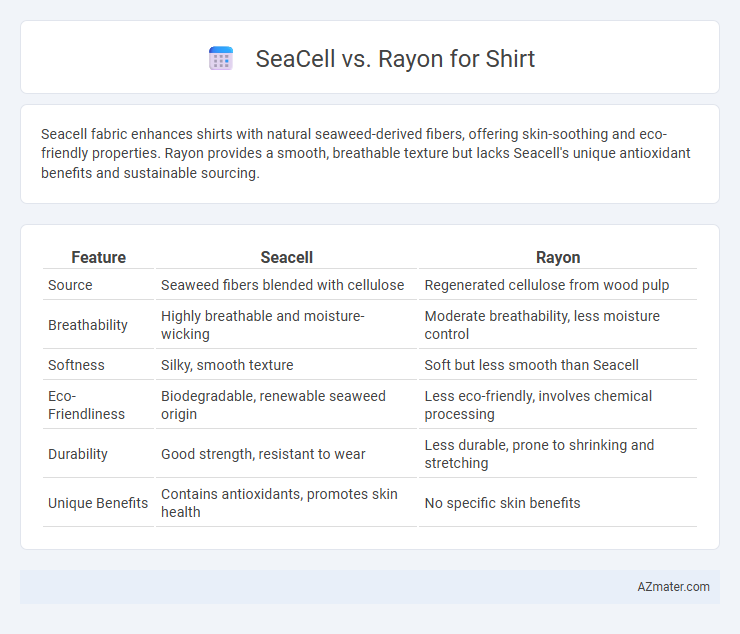Seacell fabric enhances shirts with natural seaweed-derived fibers, offering skin-soothing and eco-friendly properties. Rayon provides a smooth, breathable texture but lacks Seacell's unique antioxidant benefits and sustainable sourcing.
Table of Comparison
| Feature | Seacell | Rayon |
|---|---|---|
| Source | Seaweed fibers blended with cellulose | Regenerated cellulose from wood pulp |
| Breathability | Highly breathable and moisture-wicking | Moderate breathability, less moisture control |
| Softness | Silky, smooth texture | Soft but less smooth than Seacell |
| Eco-Friendliness | Biodegradable, renewable seaweed origin | Less eco-friendly, involves chemical processing |
| Durability | Good strength, resistant to wear | Less durable, prone to shrinking and stretching |
| Unique Benefits | Contains antioxidants, promotes skin health | No specific skin benefits |
Introduction to Seacell and Rayon
Seacell is an innovative fabric composed of cellulose fibers infused with seaweed, offering natural moisturizing properties and enhanced skin benefits, making it ideal for comfortable, eco-friendly shirts. Rayon, a semi-synthetic fiber derived from regenerated cellulose, provides breathability and softness with smooth draping, commonly used for lightweight, breathable apparel. Both materials emphasize comfort and sustainability, but Seacell distinguishes itself with added skin-nourishing elements from seaweed extracts.
Fabric Origins: How Seacell and Rayon Are Made
Seacell fabric originates from blending sustainably harvested seaweed with wood pulp, creating a bio-based fiber through a patented process that preserves the seaweed's natural nutrients. Rayon, derived from cellulose extracted primarily from wood pulp, undergoes chemical treatments to transform the cellulose into a semi-synthetic fiber suitable for textiles. The eco-friendly production of Seacell contrasts with the chemically intensive process of Rayon, influencing both their environmental footprints and fabric properties.
Environmental Impact: Seacell vs Rayon
Seacell, derived from sustainable seaweed and cellulose fibers, offers a significantly lower environmental footprint compared to traditional rayon, which relies heavily on chemically intensive processes and deforestation. The production of Seacell incorporates eco-friendly practices, including biodegradable materials and reduced water consumption, enhancing its sustainability profile. In contrast, conventional rayon manufacturing often involves toxic chemicals like carbon disulfide, causing environmental pollution and health hazards, making Seacell a more environmentally responsible choice for shirts.
Comfort and Feel: Comparing Seacell and Rayon
Seacell fabric offers superior comfort due to its natural fibers infused with seaweed, which provide enhanced breathability and moisture-wicking properties compared to Rayon. Rayon, while soft and smooth, tends to retain heat and moisture, making it less ideal for all-day comfort. The unique blend of minerals and cellulose in Seacell results in a gentle, skin-friendly feel that promotes a cooler, fresher wearing experience.
Moisture Management and Breathability
Seacell fabric excels in moisture management by incorporating seaweed fibers that naturally absorb and release moisture, keeping the skin dry and comfortable. Rayon, while soft and breathable, tends to retain moisture longer, which may lead to a clammy feel during prolonged wear. The superior breathability of Seacell enhances airflow, making it an ideal choice for shirts designed for active or humid environments.
Skin Benefits and Hypoallergenic Qualities
Seacell fabric, derived from seaweed fibers, is rich in vitamins and minerals that promote skin hydration and soothe irritation, making it ideal for sensitive skin. Rayon, made from cellulose fibers, offers softness and breathability but lacks the natural skin-nourishing properties found in Seacell. Both materials are hypoallergenic, yet Seacell's bioactive compounds provide enhanced skin benefits by reducing inflammation and supporting skin regeneration.
Durability and Longevity of Each Fabric
Seacell fabric, infused with seaweed fibers, offers moderate durability with natural moisture-wicking and antibacterial properties that enhance fabric lifespan, making it suitable for everyday wear. Rayon, a semi-synthetic fiber derived from wood pulp, tends to be less durable due to its lower tensile strength and vulnerability to abrasion and shrinking, often requiring gentle care to maintain longevity. Choosing Seacell over Rayon results in better durability and extended garment life, especially in shirts exposed to frequent washing and wear.
Style and Versatility in Shirt Design
Seacell fabric offers a unique blend of sustainable style and soft texture, making shirts not only comfortable but visually appealing with a subtle sheen that enhances casual and semi-formal looks. Rayon, known for its smooth drape and vibrant color retention, provides versatility in shirt designs ranging from lightweight summer wear to elegant office attire. Both materials allow for diverse styling options, but Seacell's eco-friendly properties add an extra layer of appeal for environmentally conscious fashion choices.
Cost and Availability in the Market
Seacell shirts generally cost more than rayon shirts due to the innovative blend of seaweed fibers and sustainable production processes, making them a premium option in the market. Rayon, made from regenerated cellulose fibers, is widely available and cheaper, benefiting from established manufacturing and distribution channels. The limited production scale of Seacell fabrics restricts availability, whereas rayon shirts are readily accessible in both budget and mid-range apparel segments worldwide.
Choosing the Best Fabric: Seacell or Rayon for Your Shirt
Seacell fabric, derived from seaweed and wood pulp, offers natural moisture-wicking and skin-soothing properties, making it ideal for sensitive skin and eco-conscious buyers. Rayon, a semi-synthetic fiber made from cellulose, provides a smooth, breathable texture with excellent drape and durability but lacks the unique bioactive benefits of Seacell. When choosing between Seacell and Rayon for shirts, prioritize Seacell for sustainability and comfort, while Rayon suits those seeking softness and versatile wearability.

Infographic: Seacell vs Rayon for Shirt
 azmater.com
azmater.com